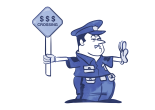Combating Smoking in Houston’s Public Housing Communities
By Aboubacar N’Diaye
Art by Blake Jones
At a press conference last week, a number of Houston’s elected and appointed public officials gathered to announce a new housing rule which would forbid smoking inside public housing units, common areas and within 25 feet of any public housing entryway. In their remarks Mayor Parker, along with Houston Housing Authority CEO Tony Gunsolley and HHA Board Vice-Chair Assata Richards, emphasized the many health and financial benefits that could result from this ban. “There’s a growing body of evidence that firsthand, secondhand and thirdhand smoke are all bad,” Gunsolley was quoted as saying to the Chronicle. ”We’re going to be bringing in smoking cessation programs and a higher level of awareness of just how dangerous secondhand smoke is.”
But in the celebratory mood, some crucial details regarding the enforcement of the new ordinance were ignored. Officials from the HHA did state that if tenants continue smoking in or around their dwellings, they may be evicted from that unit. Details on the process for this are foggy (requests for clarification have gone unanswered), but as reported in the Chronicle and in the HHA press release, a tenant in repeated violation of the ban may be evicted from the home he or she is paying for. The people who advocate for the smoking ban see this as a way to make sure that the proposal has teeth and to ensure compliance in a way that a fine could not.
And yet, when considering the proposal, it’s hard not to see another instance of a worrying trend on public poverty policy. Around the country, city and state governments have increasingly attached behavioral strings to public assistance. The Houston smoking ban itself follows similar regulation in Detroit, Seattle and Boston. Public funds recipients are now required in some states to submit to drug tests, home inspections, and show regular proof of either job searching or employment. In New York, a proposal to fingerprint public housing residents, ostensibly to help reduce crime, set off a backlash as it appeared to criminalize residents. All of these efforts aim to “reform” the poor by essentially making the conditions of their poverty so onerous, so shameful, that they will decide to get off the public dole.
I am of course not a proponent of smoking. I don’t smoke myself, and while a disturbing number of my friends do, everyone is aware of the impacts of smoking on one’s health. Encouraging public housing residents to give up smoking is a positive good, just as it would be for everyone to give up tobacco. The issue here is the manner in which this rule will be enforced. Threatening evictions may be initially effective, but it could lead to a number of unintended consequences. Unlike other reasonable nuisance rules, like loud music or loitering, smoking is an actual chemical addiction, one that takes months, if not years to kick. To ask public housing residents to basically go cold turkey when they are anywhere near their own homes is to invite evictions and to exacerbate greater poverty risk factors. Public housing units are residences of last resorts for the poor. It is either a government-subsidized apartment or the street for most residents. If residents are put out for smoking, the likely outcomes for them can be disastrous (job loss, crime, food insecurity, etc.), and much more expensive to city government in the long run.
In cases like this, when making policy in the best interests of the poor, there ought to be an actual poor person at the table, someone to situate and ground the theoretical benefits of the public policy in the practical, grimy, hard work of asking human beings to change. This is a situation which could have been better resolved with more nudge-like, incentive-based policy than the Bloombergian strategy of simply trying to force social change. A more humane, resident-centered approach would have taken the threat of eviction off the table, and instead focused on treatment programs including free nicotine-patches, support groups and addiction counseling.
If (or when) the evictions come, it is unlikely that we will hear about them. The reason why no one will make much hay over this is the same reason public residents will now have to walk a quarter-mile to have a cigarette: because the concerns of the poor are easily muted, and there is no easier group of people for politicians to “reform” than the poor- because the truth is, their vice is not smoking. It is needing help in the first place.



SMOKING RATES WENT UP ACROSS THE COUNTRY
March 13, 2024 at 4:54 pm
http://www.gallup.com/poll/167771/smoking-rate-lowest-utah-highest-kentucky.aspx
All the smoking rates WENT UP! In the Gallup poll but in my tobacco free kids smoking rates from 2024 are much lower